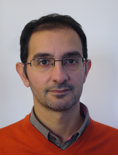Thursday July 31, 2008
Lecturer: Dr. Stefano Chessa
University of Pisa, Department of Computer Science, Italy
e-mail: stefano.chessa@isti.cnr.it
Title: Sensor Networks and their Interconnection with the wireless world
Abstract: Recent advances in Microelectro-mechanical Systems, tiny microprocessors and low power radio technologies have created low-cost, low-power, multi-functional miniature sensor devices, which can observe and react to changes in physical phenomena of their surrounding environments. When networked together over a wireless medium, these devices can provide an overall result of their sensing functionality.
Wireless sensors are battery powered and are equipped with a radio transceiver and a set of transducers through which they acquire information about the surrounding environment. When deployed in large quantities in a sensor field, these sensors can automatically organize themselves to form an ad hoc multihop network to communicate with each other and with one or more sink nodes. A remote user can inject commands into the sensor network via the sink in order to assign data collection, processing, and transfer tasks to the sensors, and it can later receive the data sensed by the network through the sink. To this purpose the sink may be connected to the internet or to satellite links.
The effective development of scalable wireless sensor networks presents a number of research challenges related to the design of energy efficient protocols implementing channel access, routing, data collection and management, and the interconnection with remote users.
This tutorial first describes the available technologies and standard for sensor network, then it provides a detailed view of the state of the art on sensor network protocols and architectures, giving special emphasis to the issues related to the interconnection with satellite links.
Index of the arguments
1. Introduction
- Applications
- Energy efficiency
2. Sensor network platforms
- Hardware platforms
- Software platforms
3. Sensor networks protocols
- MAC layer
- Network layer
- Transport layer
- Application layer
4. Remote sensing with hybrid architectures (sensors and satellite links)
- Applications
- Hybrid architectures
- Interconnection with satellite links
- Open issues
5. Test
Lecturer’s S hort Bio
hort Bio
Dr. Stefano Chessa received his MS and PhD degrees in Computer Science from the University of Pisa, Italy, in 1994 and 1999, respectively. Currently he is also Research Associate at the ISTI/CNR Institute (Information Science and Technology Institute). His research interests are in the areas of wireless ad hoc networks, and wireless sensor networks, and he has been involved in many national and European projects. In particular he is participating to the EU FP6 Network of Excellence in Satellite Networks (Satnex), to the FP6 Network of Excellence "Interactive Media with Personal Networked Devices" (InterMedia), the FP6 Strep project "Secure Middleware for Embedded Peer-to-Peer Systems" (SMEPP), and to the FP6 Integrated Project "PERceptive Spaces prOmoting iNdependent Aging" (Persona). He has co-authored about 50 papers published on international journals and conference proceedings and he is reviewer for several international journals and congresses. He has been member of the program committee of the IEEE DSN conference in 2003 and of IEEE CAMPS ‘06, MHNET ‘06, DIWANS ‘06, and SMC ’07, and he had been co-organized of the 2nd RSPSI workshop in 2007.